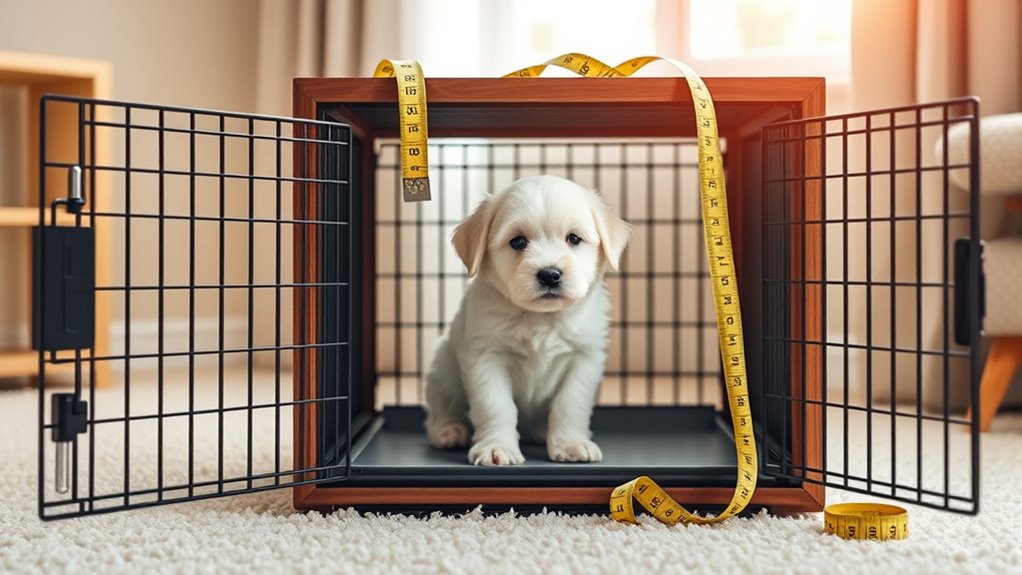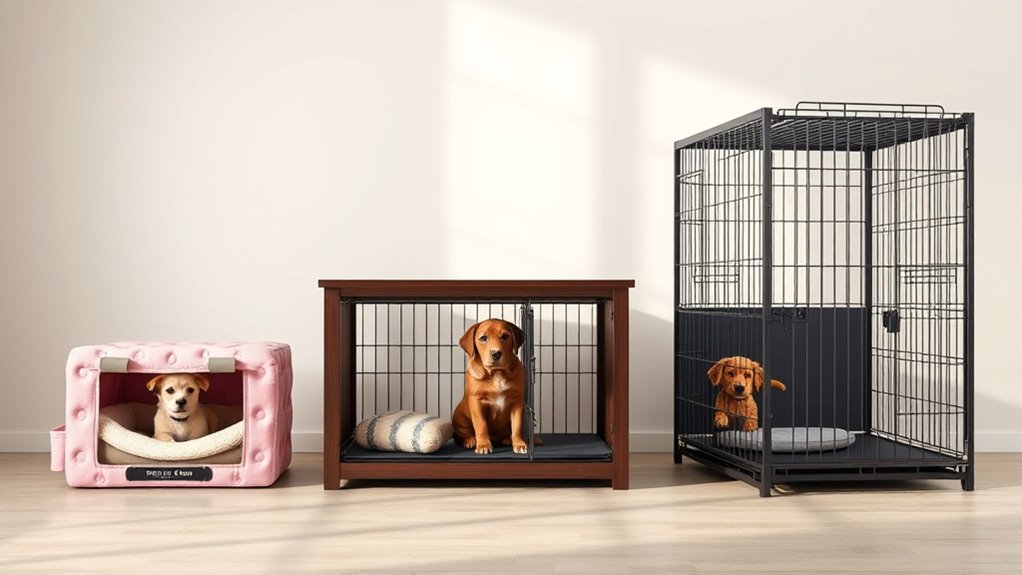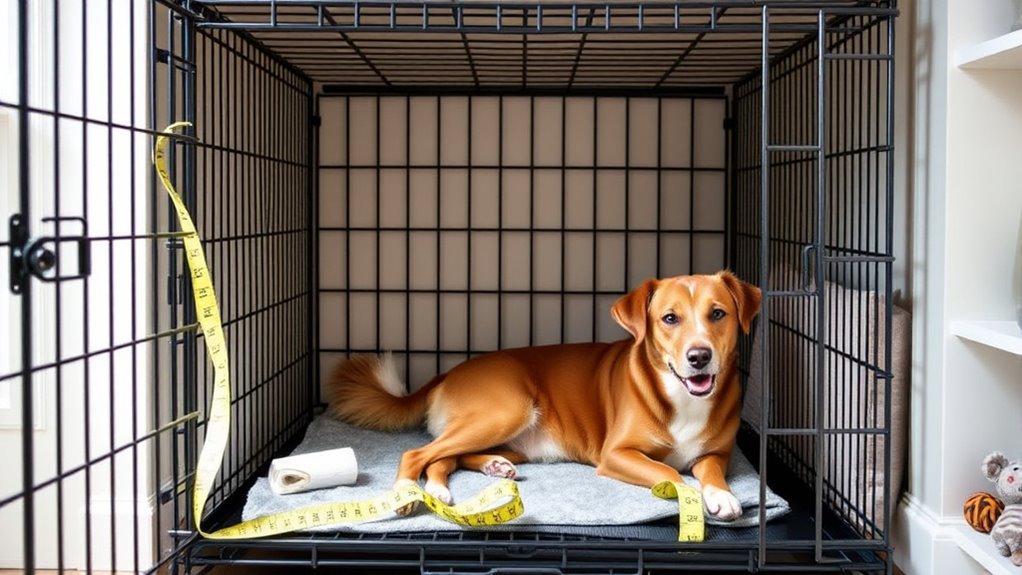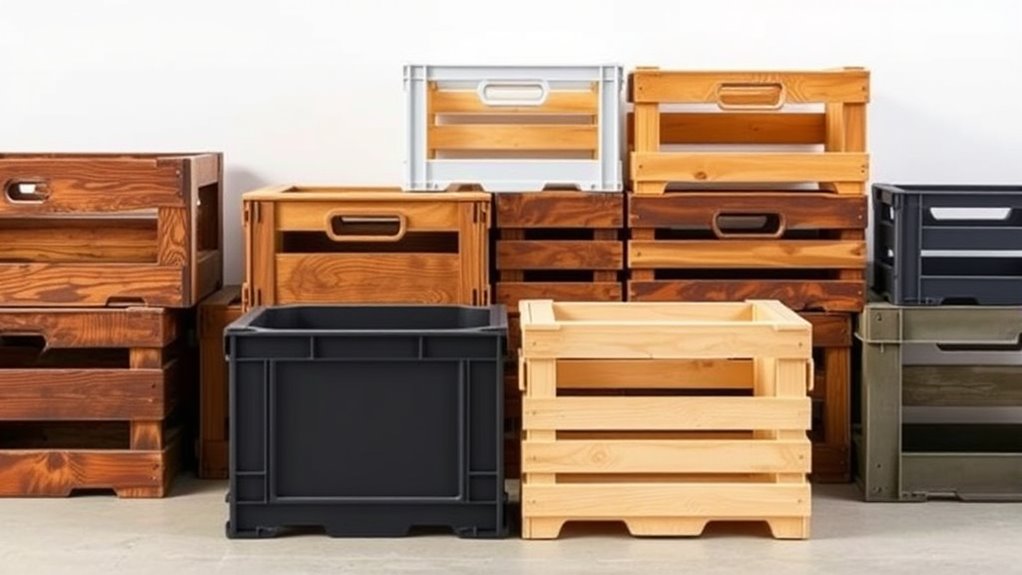To find the right crate size, start by measuring your pet’s length from nose to tail and height from the floor to their head when standing. Choose a crate that’s big enough for them to stand, turn around, and lie comfortably without being too spacious, which can cause training issues. Pay attention to your pet’s breed and size, and consider their growth potential. Keep these tips in mind to guarantee your pet’s comfort—and discover more helpful advice that can make choosing easier.
Key Takeaways
- Measure your pet’s length from nose to tail and height from floor to head when standing for accurate sizing.
- Choose a crate that allows your pet to stand, turn around, and lie comfortably without being too spacious.
- Refer to breed-specific size guidelines to select a crate that fits your pet’s current and future growth.
- Avoid oversized crates to prevent your pet from using corners as a bathroom; opt for a snug fit for training.
- Consider the material and style that suit your pet’s activity level and travel needs for optimal comfort and safety.
Understanding Your Pet’s Size and Breed

To choose the right crate size, you first need to understand your pet’s size and breed. Knowing these details helps you select a crate that promotes effective dog training and comfortable crate training techniques. Larger breeds require bigger crates to stand, turn around, and lie down comfortably, while smaller breeds need a more snug fit. Consider your dog’s current size and their expected growth if they’re still young. An appropriately sized crate encourages positive behavior and reduces anxiety during crate training. Avoid choosing a crate that’s too big, as your pet might use one corner as a bathroom. By understanding your pet’s breed characteristics and size, you set a foundation for successful crate training and ensure your dog feels safe and secure in their new space. Additionally, selecting a crate with superior ventilation and filtration can help maintain a healthy environment for your pet. Incorporating modern automation technologies such as climate control and automated feeding can further enhance your pet’s comfort and well-being.
Measuring Your Pet for the Perfect Fit

Measuring your pet accurately is essential to find a crate that fits perfectly and guarantees their comfort. Start by measuring your pet’s length from nose to tail and their height from the floor to the top of their head when standing. Use a flexible tape measure for precise results. Incorporate calming techniques during the process to keep your pet relaxed, such as speaking softly or offering treats. Proper measurements help you select a crate that provides enough space for your pet to stand, turn, and lie down comfortably. Understanding crate sizing can help you select the right size and avoid common mistakes. These measurements also support effective crate training tips, making the experience less stressful for your pet. When in doubt, choose a slightly larger size to ensure comfort and ease of movement. Accurate measurement sets the foundation for successful crate training and a happy, relaxed pet. Additionally, understanding credit card terms can improve your overall financial management when purchasing pet supplies. Knowing about pinball machine weight can also be useful when arranging for crate delivery or setup. Being aware of air purifier features can help you choose the best model to ensure a clean environment for your pet.
Common Crate Sizes for Different Breeds

Are you aware that crate sizes vary considerably depending on your dog’s breed and size? For small breeds like Chihuahuas or Yorkshire Terriers, a crate around 19 to 24 inches suits their compact frame, offering proper crate ventilation without feeling cramped. Medium breeds such as Beagles or Cocker Spaniels typically require 24 to 30 inches, providing enough room for movement and comfort. Larger breeds like Labrador Retrievers or German Shepherds need 36 to 42 inches, ensuring they can stand, turn, and stretch comfortably. When choosing a crate, consider travel compatibility—smaller crates are easier for car trips, while larger ones may need additional safety features. Proper sizing guarantees good crate ventilation, prevents stress, and makes travel more manageable for your pet. Additionally, understanding the appropriate crate size can help prevent potential health issues related to cramped conditions, especially when considering shower best modern toilet for bathroom upgrades. Being aware of dog crate dimensions tailored to different breeds ensures your pet’s comfort and safety during both home stays and travel. A well-chosen crate size also aligns with Textile Art principles such as balance and proportion, ensuring your pet’s space is both functional and comfortable.
Signs That Your Pet’s Crate Is Too Small or Too Large

A crate that’s too small can cause your pet to feel cramped, leading to discomfort, stress, and even behavioral issues. If your pet struggles to turn around or stretch comfortably, it’s a clear sign the crate isn’t the right size. Poor crate ventilation can exacerbate these problems, making the space feel even more confined and uncomfortable. Additionally, sufficient ventilation is essential for maintaining airflow and reducing humidity inside the crate, which helps keep your pet comfortable. Proper ventilation systems can also prevent the buildup of odors and ensure your pet receives fresh air, promoting overall health. Moreover, selecting a crate with appropriate size and dimensions supports better airflow and comfort for your pet. Conversely, if the crate is too large, your pet might have trouble feeling secure, which can hinder training and cause anxiety. Pay attention to crate placement as well; a crate placed in a drafty or noisy area can make your pet uneasy, regardless of size. Ensuring the crate fits your pet’s needs and is placed in a calm, well-ventilated spot helps promote comfort and proper crate training. Additionally, understanding crate sizing can help you select the appropriate dimensions for your pet’s comfort and safety.
Tips for Choosing the Right Material and Style

Choosing the right crate material and style can make a significant difference in your pet’s comfort and your ease of use. The crate material impacts durability, ventilation, and cleanliness, while the crate style influences accessibility and portability. For example, a wire crate offers good airflow and visibility, ideal for active pets. A plastic crate provides privacy and is great for travel, but may limit ventilation. Soft-sided crates are lightweight and portable, perfect for short trips, but less durable. Consider your pet’s behavior and environment when selecting, and remember that crate safety should always be a priority to ensure your pet’s well-being. Additionally, understanding equity buyer expectations for quality and design can help you choose a crate that meets both functional and aesthetic needs. When choosing a crate, it’s also helpful to research durability factors to ensure the crate will stand up to your pet’s habits and longevity needs. Being aware of cheating husband secrets can also be relevant if you’re dealing with household trust issues affecting your pet care decisions.
Frequently Asked Questions
How Often Should I Replace My Pet’S Crate?
You might wonder how often to replace your pet’s crate. Generally, you should replace it when it becomes unsafe, damaged, or no longer fits your pet’s size. Regular crate training promotes pet safety and comfort, so guarantee the crate is sturdy and appropriate. Keep an eye out for wear and tear, and don’t hesitate to upgrade if it no longer provides a secure environment. This keeps your pet safe and comfortable.
Can My Pet Grow Into a Larger Crate?
Yes, your pet can grow into a larger crate over time. When choosing a bigger crate, consider the crate material to guarantee durability and comfort. Adequate crate ventilation is also vital for airflow and your pet’s safety. Regularly assess your pet’s size and behavior, and upgrade to a larger crate when needed, making certain it provides enough space for movement and comfort as your pet grows.
Are Collapsible Crates Safer Than Fixed Ones?
Sure, collapsible crates are the superheroes of convenience, but are they safer than fixed crates? Not necessarily. While collapsible crates offer portability and storage ease, fixed crates often provide more stability and durability. If safety is your priority, consider the sturdiness of fixed crates. But if you’re looking for quick setup and portability, collapsible crates might just be the charming, albeit slightly riskier, choice. Choose wisely!
What if My Pet Refuses to Use the Crate?
If your pet refuses to use the crate, don’t get discouraged. Focus on crate training by making the crate a positive, comfortable space for your pet. Use treats, praise, and patience to encourage them to enter voluntarily. Ensuring pet comfort is key—add soft bedding and keep the crate in a quiet area. With consistent training and positive reinforcement, your pet will gradually accept the crate as a safe, cozy spot.
How Do I Sanitize My Pet’S Crate Effectively?
To sanitize your pet’s crate effectively, start by removing all bedding and toys. Use a mild, pet-safe disinfectant, paying attention to the crate material—metal, plastic, or fabric—since each requires different cleaning methods. make certain good ventilation options by cleaning in a well-ventilated area, and let the crate air dry completely before reassembling. Regular cleaning keeps it hygienic and prevents bacteria buildup, keeping your pet safe and healthy.
Conclusion
Choosing the right crate isn’t just about size—it’s about creating a cozy haven your pet feels safe in. When you pick the perfect fit, your furry friend will settle in comfortably and happily, like finding that ideal nook in a busy room. Trust your instincts and pay attention to their cues. A thoughtfully selected crate becomes a gentle retreat, making both your lives easier and more joyful. After all, comfort is the key to a happy, well-adjusted pet.










